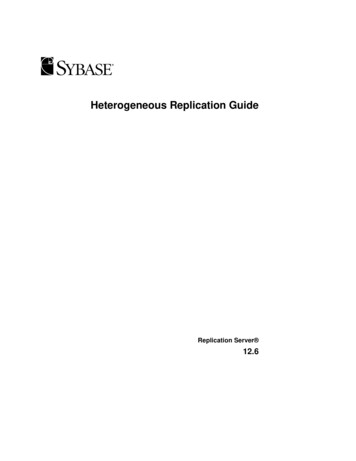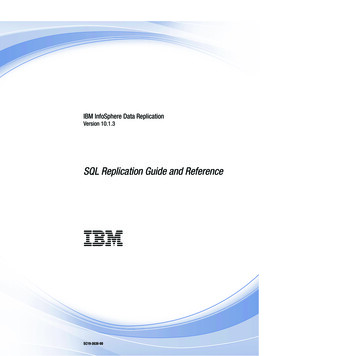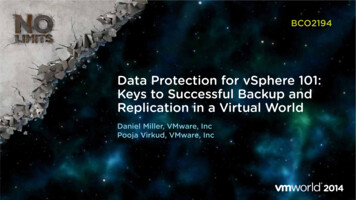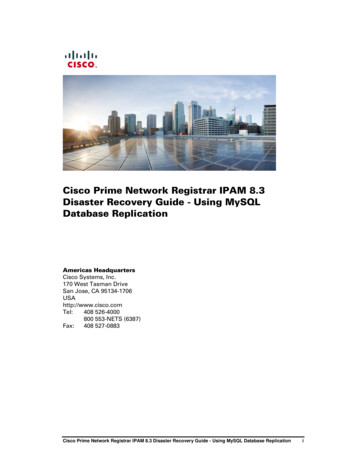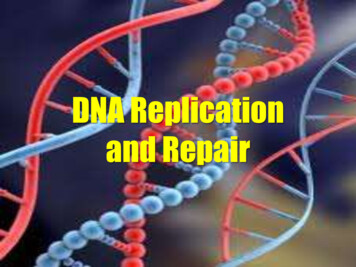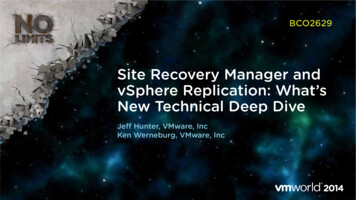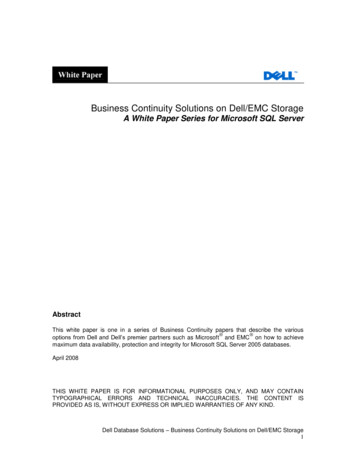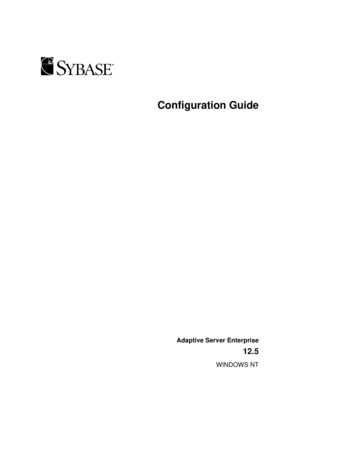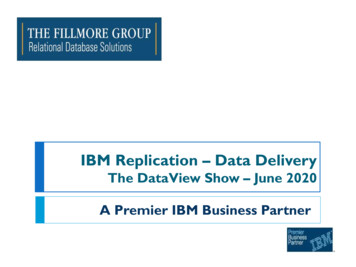![[MS-DPREP-Diff]: Replication Data Portability Overview](/img/42/ms-dprep-170816-diff.jpg)
Transcription
[MS-DPREP-Diff]:Replication Data Portability OverviewIntellectual Property Rights Notice for Open Specifications Documentation Technical Documentation. Microsoft publishes Open Specifications documentation (“thisdocumentation”) for protocols, file formats, data portability, computer languages, and standardsas well as overviews of the interaction among each of these technologiessupport. Additionally,overview documents cover inter-protocol relationships and interactions.Copyrights. This documentation is covered by Microsoft copyrights. Regardless of any otherterms that are contained in the terms of use for the Microsoft website that hosts thisdocumentation, you maycan make copies of it in order to develop implementations of thetechnologies that are described in the Open Specifications this documentation and maycandistribute portions of it in your implementations usingthat use these technologies or in yourdocumentation as necessary to properly document the implementation. You maycan also distributein your implementation, with or without modification, any schema, IDL'sschemas, IDLs, or codesamples that are included in the documentation. This permission also applies to any documentsthat are referenced in the Open Specifications. documentation.No Trade Secrets. Microsoft does not claim any trade secret rights in this documentation.Patents. Microsoft has patents that maymight cover your implementations of the technologiesdescribed in the Open Specifications. documentation. Neither this notice nor Microsoft's delivery ofthethis documentation grants any licenses under those patents or any other Microsoft patents.However, a given Open Specification maySpecifications document might be covered by theMicrosoft Open Specifications Promise or the Microsoft Community Promise. If you would prefer awritten license, or if the technologies described in the Open Specificationsthis documentation arenot covered by the Open Specifications Promise or Community Promise, as applicable, patentlicenses are available by contacting iplg@microsoft.com.License Programs. To see all of the protocols in scope under a specific license program and theassociated patents, visit the Patent Map.Trademarks. The names of companies and products contained in this documentation maymightbe covered by trademarks or similar intellectual property rights. This notice does not grant anylicenses under those rights. For a list of Microsoft trademarks, visit.www.microsoft.com/trademarks.Fictitious Names. The example companies, organizations, products, domain names, e-mailemailaddresses, logos, people, places, and events that are depicted in this documentation are fictitious.No association with any real company, organization, product, domain name, email address, logo,person, place, or event is intended or should be inferred.Reservation of Rights. All other rights are reserved, and this notice does not grant any rights otherthan as specifically described above, whether by implication, estoppel, or otherwise.Tools. The Open Specifications dodocumentation does not require the use of Microsoft programmingtools or programming environments in order for you to develop an implementation. If you have accessto Microsoft programming tools and environments, you are free to take advantage of them. CertainOpen Specifications documents are intended for use in conjunction with publicly availablestandardstandards specifications and network programming art, and assumes, as such, assume thatthe reader either is familiar with the aforementioned material or has immediate access to it.Support. For questions and support, please contact dochelp@microsoft.com.1 / 11[MS-DPREP-Diff] - v20170816Replication Data Portability OverviewCopyright 2017 Microsoft CorporationRelease: August 16, 2017
Revision /20110.1NewRelease new document7/7/20110.1NoneNo changes to the meaning, language, or formatting of thetechnical content.11/3/20110.1NoneNo changes to the meaning, language, or formatting of thetechnical content.1/19/20120.1NoneNo changes to the meaning, language, or formatting of thetechnical content.2/23/20120.1NoneNo changes to the meaning, language, or formatting of thetechnical content.3/27/20120.1NoneNo changes to the meaning, language, or formatting of thetechnical content.5/24/20120.1NoneNo changes to the meaning, language, or formatting of thetechnical content.6/29/20120.1NoneNo changes to the meaning, language, or formatting of thetechnical content.7/16/20120.1NoneNo changes to the meaning, language, or formatting of thetechnical content.10/8/20120.1NoneNo changes to the meaning, language, or formatting of thetechnical content.10/23/20120.1NoneNo changes to the meaning, language, or formatting of thetechnical content.3/26/20130.1NoneNo changes to the meaning, language, or formatting of thetechnical content.6/11/20131.0MajorUpdated and revised the technical content.8/8/20132.0MajorUpdated and revised the technical content.12/5/20132.0NoneNo changes to the meaning, language, or formatting of thetechnical content.2/11/20142.0NoneNo changes to the meaning, language, or formatting of thetechnical content.5/20/20142.0NoneNo changes to the meaning, language, or formatting of thetechnical content.5/10/20162.0NoneNo changes to the meaning, language, or formatting of thetechnical content.8/16/20172.1MinorClarified the meaning of the technical content.2 / 11[MS-DPREP-Diff] - v20170816Replication Data Portability OverviewCopyright 2017 Microsoft CorporationRelease: August 16, 2017
Table of Contents1Introduction . 41.1Glossary . 41.2References . 52Data Portability Scenario . 72.1Retrieve Intellectual Property from a Replication Topology . 72.1.1Data Description . 72.1.2Format and Protocol Summary . 82.1.3Data Portability Methodology . 82.1.3.1Preconditions . 82.1.3.2Versioning . 82.1.3.3Error Handling . 92.1.3.4Coherency Requirements . 92.1.3.5Additional Considerations . 93Change Tracking . 104Index . 113 / 11[MS-DPREP-Diff] - v20170816Replication Data Portability OverviewCopyright 2017 Microsoft CorporationRelease: August 16, 2017
1IntroductionThe Replication Data Portability Overview document provides an overview of the components andmethodologies that are used for data portability with the SQL Server Replication system.In this document, replication refers to logical replication of data by using Microsoft SQL Server 2008R2.Replication is a set of technologies for copying and distributing data and database objects from onedatabase to another and then synchronizing between databases to maintain consistency. By usingreplication, you can distribute data to different locations and to remote or mobile users over local andwide area networks, dial-up connections, wireless connections, and the Internet.Transactional replication is typically used in server-to-server scenarios that require high throughputscalability and availability. It is used to feed data warehouse and reporting systems, integrate datafrom multiple sites, integrate heterogeneous data, and offload batch processing. Merge replication isprimarily designed for mobile applications or distributed server applications that have possible dataconflicts. Common scenarios include exchanging data with mobile users, consumer point of sale (POS)applications, and integration of data from multiple sites. Snapshot replication is used to provide theinitial data set for transactional and merge replication; it can also be used when complete refreshes ofdata are appropriate. With these three types of replication, Microsoft SQL Server provides a powerfuland flexible system for synchronizing data across your enterprise.Replication is implemented by using the following two-step process after the replication topology is setup: Step 1: Initial synchronization. Synchronization through which SQL Server delivers a snapshotto the destination. During this step, SQL Server ensures that the destination has the initial schemaand data so that it can send only the subsequent changes during the next synchronizations. Step 2: Subsequent synchronization. Synchronization that occurs after the snapshot isdelivered. In this type of synchronization, only the data that corresponds to changes that occurredsince the last synchronization is delivered to the destination.For more information about what replication is and how it works, see SQL Server Replication [MSDNRepMain].This document provides a high-level overview of the following items: The location where the user data is stored and how to access it. The details of the replication topology and how to access it. Information about which user changes need to be replicated and how to view them.1.1GlossaryThis document uses the following terms:article: A database object, such as a table, view, or stored procedure, that is included in apublication. For more information, see [MSDN-RepPub].Distributor database instance: A database instance that acts as a store for replication-specificdata that is associated with one or more Publishers. For more information, see [MSDN-RepPub].Log Reader Agent: A replication agent that moves transactions marked for replication from thetransaction log on the Publisher to the distribution database.4 / 11[MS-DPREP-Diff] - v20170816Replication Data Portability OverviewCopyright 2017 Microsoft CorporationRelease: August 16, 2017
publication: A collection of one or more articles from one database. For more information, see[MSDN-RepPub].Publisher database instance: A database instance that makes data available to other locationsthrough replication. A Publisher can have one or more publications, each defining a logicallyrelated set of objects and data to replicate. For more information, see [MSDN-RepPub].SQL Server Agent: A replication agent that hosts and schedules the agents used in replication andprovides an easy way to run replication agents. For more information, see [MSDN-RepAgent].Subscriber database instance: A database instance that receives replicated data. A Subscribercan receive data from multiple Publishers and publications. Depending on the type of replicationchosen, the Subscriber can also pass data changes back to the Publisher or republish the data toother Subscribers. For more information, see [MSDN-RepPub].subscription: A request for a copy of a publication to be delivered to a subscriber. For moreinformation, see [MSDN-RepPub].1.2ReferencesLinks to a document in the Microsoft Open Specifications library point to the correct section in themost recently published version of the referenced document. However, because individual documentsin the library are not updated at the same time, the section numbers in the documents may notmatch. You can confirm the correct section numbering by checking the Errata.[MSDN-BrwseRepCmd] Microsoft Corporation, "sp browsereplcmds brary/ms176109.aspx[MSDN-HlpArtcle] Microsoft Corporation, "sp helparticle brary/ms187741.aspx[MSDN-HlpDist] Microsoft Corporation, "sp helpdistributor brary/ms177504.aspx[MSDN-HlpMrgeArtcle] Microsoft Corporation, "sp helpmergearticle brary/ms174278.aspx[MSDN-HlpMrgeFltr] Microsoft Corporation, "sp helpmergefilter brary/ms190294.aspx[MSDN-HlpMrgePub] Microsoft Corporation, "sp helpmergepublication brary/ms189475.aspx[MSDN-HlpMrgePullSub] Microsoft Corporation, "sp helpmergepullsubscription brary/ms186319.aspx[MSDN-HlpMrgeSub] Microsoft Corporation, "sp helpmergesubscription brary/ms189437.aspx[MSDN-HlpPub] Microsoft Corporation, "sp helppublication brary/ms189782.aspx[MSDN-HlpPullSub] Microsoft Corporation, "sp helppullsubscription brary/ms187714.aspx[MSDN-HlpSrvr] Microsoft Corporation, "sp helpserver brary/ms189804.aspx5 / 11[MS-DPREP-Diff] - v20170816Replication Data Portability OverviewCopyright 2017 Microsoft CorporationRelease: August 16, 2017
[MSDN-HlpSubProp] Microsoft Corporation, "sp helpsubscription properties brary/ms186254.aspx[MSDN-HlpSub] Microsoft Corporation, "sp helpsubscription brary/ms190493.aspx[MSDN-RepErr] Microsoft Corporation, "Errors and Events Reference rary/ms152467.aspx[MSDN-RepMain] Microsoft Corporation, "SQL Server Replication", px[MSDN-RepShowCmd] Microsoft Corporation, "sp replshowcmds brary/ms175114.aspx[MSDN-ShoChnge] Microsoft Corporation, "sp showpendingchanges brary/ms186795.aspx6 / 11[MS-DPREP-Diff] - v20170816Replication Data Portability OverviewCopyright 2017 Microsoft CorporationRelease: August 16, 2017
22.1Data Portability ScenarioRetrieve Intellectual Property from a Replication TopologyThis scenario describes extracting the replication topology information from a Microsoft SQL Serverdatabase. The information is retrieved by SQL Server stored procedures that are executed from SQLServer Management Studio. To export them, the user can save the result set from SQL ServerManagement Studio in any format supported by that tool, such as text or CSV.2.1.1 Data DescriptionInfrastructure informationWhich servers are participating in a replication topology can be found by running the sp helpserverstored procedure [MSDN-HlpSrvr] on the master database of any server.This stored procedure reports information about a particular remote server or replication server, orabout all servers of both types. It provides the server name, the network name of the server, thereplication status of the server, the identification number of the server, and the collation name. It alsoprovides time-out values for connecting to, or running queries against, linked servers. Replicationstatus is reported by the stored procedure as follows: pub: A Publisher database instance. dist: A Distributor database instance. sub: A Subscriber database instance.Source and destination object informationMore information about a Distributor is available by running the sp helpdistributor stored procedure[MSDN-HlpDist] at the Publisher on the publication database or any database. This stored procedurelists information about the Distributor, distribution database, working directory, and SQL Server Agentuser account.A list of which objects are published is available through the list of publications, which can be obtainedfrom the system by executing the following stored procedures on the Publishers: sp helppublication [MSDN-HlpPub] for snapshot and transactional replication. sp helpmergepublication [MSDN-HlpMrgePub] for merge replication.To return the list of the objects from the source database that are published and the names of thedestination objects, use either of the following stored procedures on the Publishers: sp helparticle [MSDN-HlpArtcle] sp helpmergearticle [MSDN-HlpMrgeArtcle]If a filter has been defined between two articles that are participating to a merge publication, thedefinition of this filter can be found by running the sp helpmergefilter stored procedure [MSDNHlpMrgeFltr].The list of subscriptions as well as details about the subscriptions can be found by running thefollowing stored procedures: sp helpsubscription [MSDN-HlpSub] sp helppullsubscription [MSDN-HlpPullSub]7 / 11[MS-DPREP-Diff] - v20170816Replication Data Portability OverviewCopyright 2017 Microsoft CorporationRelease: August 16, 2017
sp helpmergesubscription [MSDN-HlpMrgeSub] sp helpmergepullsubscription [MSDN-HlpMrgePullSub]Among other things, these stored procedures return the name of the Subscribers and the names ofthe subscribing databases.More generic information about a subscription can be found by running thesp helpsubscription properties stored procedure [MSDN-HlpSubProp].2.1.2 Format and Protocol SummaryThe information that is retrieved from SQL Server is exported in text format.2.1.3 Data Portability MethodologyA user can extract the data from Management Studio by executing the stored procedures that areshared in this document, and then saving the results to a file on disk.2.1.3.1 Preconditions Servers mustare required to be online. Databases mustare required to have been created. Replication mustis required to have been set up. At least one publication mustis required to have been created. At least one valid article mustis required to have been created for this publication. At least one subscription mustis required to have been created.2.1.3.2 VersioningThis scenario applies to the following versions, including released service packs: Windows XP operating system Windows Server 2003 operating system Windows Server 2003 R2 operating system Windows Server 2008 operating system Windows 7 operating system Windows Server 2008 R2 operating system Windows 8 operating system Windows Server 2012 operating system Windows 8.1 operating system Windows Server 2012 R2 operating system8 / 11[MS-DPREP-Diff] - v20170816Replication Data Portability OverviewCopyright 2017 Microsoft CorporationRelease: August 16, 2017
2.1.3.3 Error HandlingThe stored procedures referred to in this document have built-in error handling and raise specificmessages depending on the error conditions. For more information, see [MSDN-RepErr].2.1.3.4 Coherency RequirementsThere are no special coherency requirements.2.1.3.5 Additional ConsiderationsIn the case of transactional replication, SQL Server propagates transactions. Transactions and theircommands are harvested from the transaction log of the published database. The user can view thetransactions that are waiting for the Log Reader Agent to propagate them to the distribution databaseby executing the sp replshowcmds stored procedure [MSDN-RepShowCmd].The actual Transact-SQL commands within those transactions are then stored in the distributiondatabase. The user can view the list of those commands and transactions by executing thesp browsereplcmds stored procedure [MSDN-BrwseRepCmd].In the case of merge replication, SQL Server does not propagate the commands of a transaction butreplicates net changes. In merge replication, each row of any table participating in merge replication isidentified by a uniqueidentifier. To determine which changes mustare required to be replicated, theuser can execute the sp showpendingchanges stored procedure [MSDN-ShoChnge].By using the rowguids (uniqueidentifiers) that are returned by this procedure, the user can querythe user table to identify which row mustis required to be replicated.9 / 11[MS-DPREP-Diff] - v20170816Replication Data Portability OverviewCopyright 2017 Microsoft CorporationRelease: August 16, 2017
3Change TrackingNo table of This section identifies changes is available. The that were made to this document is eithernew or has had no changes since itsthe last release. Changes are classified as Major, Minor, or None.The revision class Major means that the technical content in the document was significantly revised.Major changes affect protocol interoperability or implementation. Examples of major changes are: A document revision that incorporates changes to interoperability requirements.A document revision that captures changes to protocol functionality.The revision class Minor means that the meaning of the technical content was clarified. Minor changesdo not affect protocol interoperability or implementation. Examples of minor changes are updates toclarify ambiguity at the sentence, paragraph, or table level.The revision class None means that no new technical changes were introduced. Minor editorial andformatting changes may have been made, but the relevant technical content is identical to the lastreleased version.The changes made to this document are listed in the following table. For more information, pleasecontact ass1IntroductionClarified that replication is not limited to the use of a specific version ofSQL Server.Minor10 / 11[MS-DPREP-Diff] - v20170816Replication Data Portability OverviewCopyright 2017 Microsoft CorporationRelease: August 16, 2017
4IndexCChange tracking 10GGlossary 4IInformative references 5Introduction 4RReferences 5TTracking changes 1011 / 11[MS-DPREP-Diff] - v20170816Replication Data Portability OverviewCopyright 2017 Microsoft CorporationRelease: August 16, 2017
data are appropriate. With these three types of replication, Microsoft SQL Server provides a powerful and flexible system for synchronizing data across your enterprise. Replication is implemented by using the following two-step process after the replication topology is set up: Step 1: Initial synchronization.
![[MS-DPREP]: Replication Data Portability Overview](/img/42/5bms-dprep-5d.jpg)
